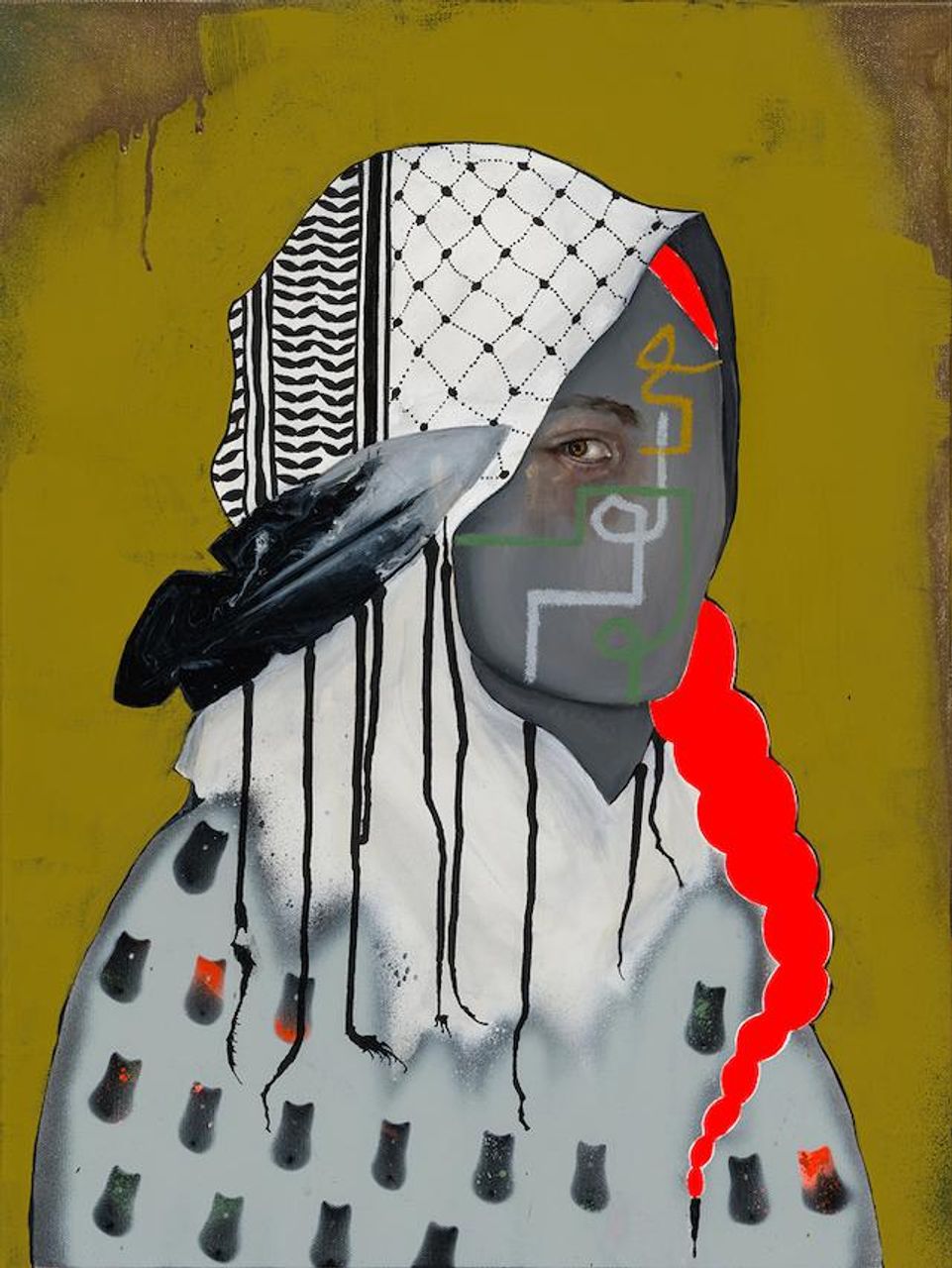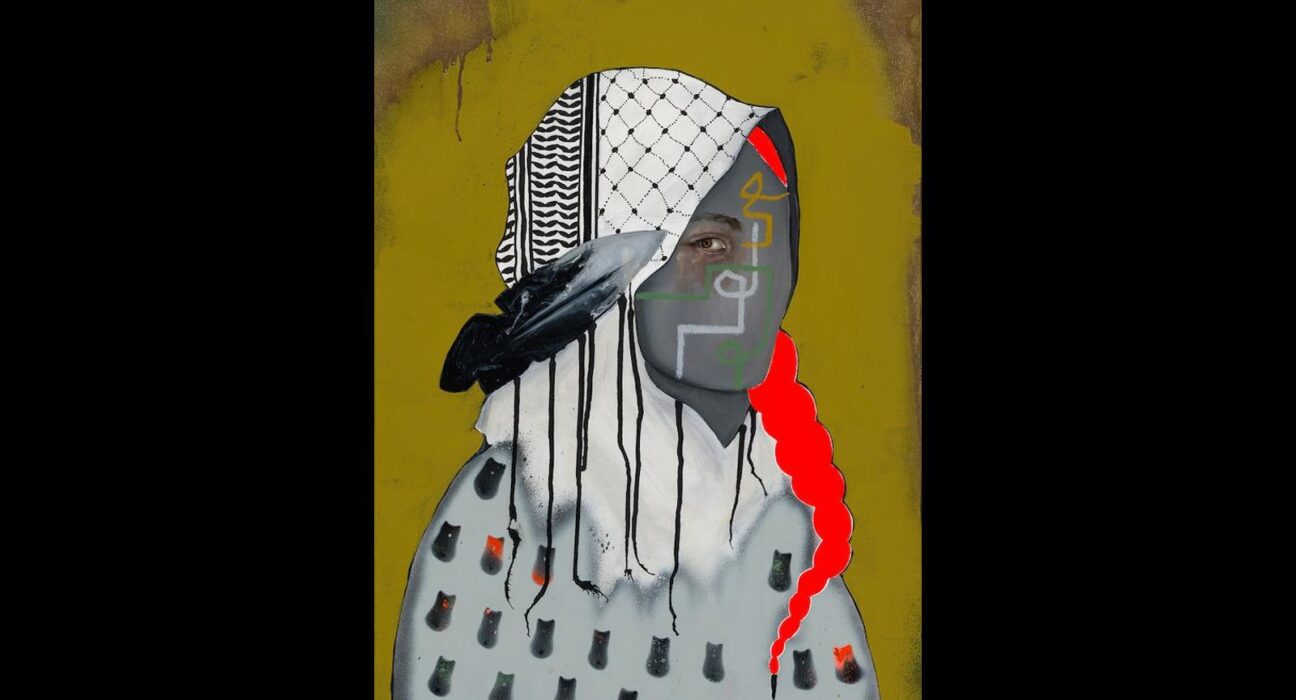The systematic censorship in the US of artists who express sympathy with the plight of the Gazan population and oppose the genocidal policies of Netanyahu-Biden continues.
*The National Coalition Against Censorship (NCAC) has felt obliged to create an “Art Censorship Index,” primarily reporting the most egregious, official acts of censorship favoring the murderous Israeli military attacks on the Palestinians.
*In an episode that the NCAC has not yet had time to list, Native American artist Danielle SeeWalker recently had an invitation rescinded to be artist in residence in Vail, Colorado, the Rocky Mountain resort town. The artist had done a painting G is for Genocide, of a woman wearing a keffiyeh, and posted an image of the work on Instagram.

*Meanwhile, chat messages obtained by the Washington Post reveal that a secret cabal of wealthy art collectors and “art-world stakeholders,” with connections to major museums in New York and elsewhere, discussed plans to put pressure on Mayor Eric Adams to break up the protests by students at Columbia University and other campuses.
The NCAC index provides information on a series of episodes in which institutions have acted on behalf of pro-Israeli forces to clamp down on artists’ free speech. The WSWS has written about a number of them, including the exclusion of Palestinian artist Jumana Manna from a panel at the Wexner Center for the Arts in Columbus, Ohio; the cancellation of a career retrospective by Palestinian artist Samia Halaby at Indiana University; the shutting down of scheduled showings of Israelism, a film critical of Zionist policies, at Hunter College in New York and the University of Pennsylvania in Philadelphia; and the “postponement” of an appearance by Vietnamese-American Pulitzer Prize-winning writer Viet Thanh Nguyen at the 92nd Street Y in Manhattan.
It notes the cancellation of appearances by author Nathan Thrall, author of the Pulitzer Prize-winning A Day in the Life of Abed Salama, at a number of venues, including the Writers Bloc in Los Angeles and the University of Arkansas.
The Burning Man festival in Nevada, which pledges itself to “community, art, self-expression, and self-reliance,” removed from its website a pro-Palestinian art work, a proposed 8-by-14-foot fiberglass installation in the shape of a watermelon, a symbol of resistance to Israeli occupation. The title of the work was “From the River to the Sea,” and various pro-Zionists objected, claiming that the slogan constituted “language that advocates for the annihilation of Israel.”
The published NCAC list includes the “sudden” postponing by the Frick Pittsburgh museum of the exhibition Treasured Ornament: 10 Centuries of Islamic Art, the cancellation of the Boston Palestine Film Festival after venues faced “a lot of pressure and backlash” from pro-Israeli forces; the removal of an art installation at East Harlem’s El Museo del Barrio that included a Palestinian flag; and numerous others.
The list is quite narrow, in fact. A far broader range of acts of censorship and repression have been carried out, as the NCAC itself acknowledges. The organization explains that it did not include “cases in which artists substantially altered their own work after it had been curated, or cases where curatorial frameworks precluded an artwork from being selected in the first place.” Furthermore, the list “does not record employee firings, instances in which galleries have terminated their representation of artists, expulsions of student groups from college campuses, or instances in which protests have temporarily interfered with the presentation of work.”
As well, the “Art Censorship Index” does not record “examples in which artists have elected to withdraw their work from public presentation in an act of protest, or instances in which artists have self-censored their work or their views for fear of backlash.” In short, the NCAC admits that “the data represented likely reflect a fraction of arts censorship incidents, and that the current political climate’s chilling effects on speech reverberate in myriad ways beyond the incidents noted.”
The latest episode in Vail has become the norm. SeeWalker, a Húŋkpapȟa Lakȟóta citizen of the Standing Rock Sioux Nation based in Denver, was invited to be the town’s artist in residence, and then disinvited once she posted G for Genocide on Instagram. As the artist told the Art Newspaper, G for Genocide “was for a different exhibition and had nothing to do with Vail or the residency.”
The municipality, in a statement, asserted that while “the Town of Vail embraces [SeeWalker’s] messaging and artwork surrounding Native Americans, in recent weeks her art and her public messaging has focused on the Israel/Gaza crisis.” It then claimed, as has also become the norm, that negotiations with SeeWalker had never been concluded and no contract was signed, etc. However, the Art Newspaper pointed out that its review of materials indicated that “SeeWalker received written commitments for housing and supplies. An announcement about her arrival in Vail that had been posted on the municipality’s website has since been taken down.”
One of the most sinister and telling incidents is the intervention by super-wealthy art collectors to press the city of New York to crack down on student protesters at Columbia and other universities.
As Hyperallergic reports, the messages urging NYPD intervention
were sent in a private WhatsApp group whose members reportedly included collector Len Blavatnik, a major benefactor of institutions including London’s Victoria and Albert Museum and Tate Modern; tech tycoon Michael Dell, who helped establish the Magnum Photos collection at the University of Texas at Austin; Daniel Loeb, art collector and former Los Angeles Museum of Contemporary Art trustee; former Starbucks CEO and momentary presidential hopeful Howard Schultz, a top Seattle art collector; and Joseph Sitt, the real-estate investor behind Brooklyn’s Sephardic Heritage Museum and the Coney Art Walls mural initiative.
The article goes on to report that on April 27, according to the Washington Post,
Sitt, Blavatnik, Loeb, and others attended a Zoom call with New York City Mayor Eric Adams in the wake of mass student arrests at Columbia and as a new encampment emerged on campus. Sitt wrote that Adams was “open to any ideas we have” to address the campus protests, including hiring private investigators “to then have his police force intel team work with them.”
The article continues:
“I’ll be grateful when the perpetrators are dragged off campus,” Loeb reportedly wrote in the chat that day. Minutes of the Zoom call shared in the chat noted potential tactics to get police back on campus, including donating to Adams’s reelection campaign and using the group members’ “leverage” to influence Columbia University President Nemat “Minouche” Shafik.
Days later, the NYPD violently removed and arrested students occupying Columbia’s Hamilton Hall, renamed Hind’s Hall, in honor of Hind Rajab, the six-year-old child murdered by Israeli forces in Gaza in January 2024.
Join the fight for socialism

